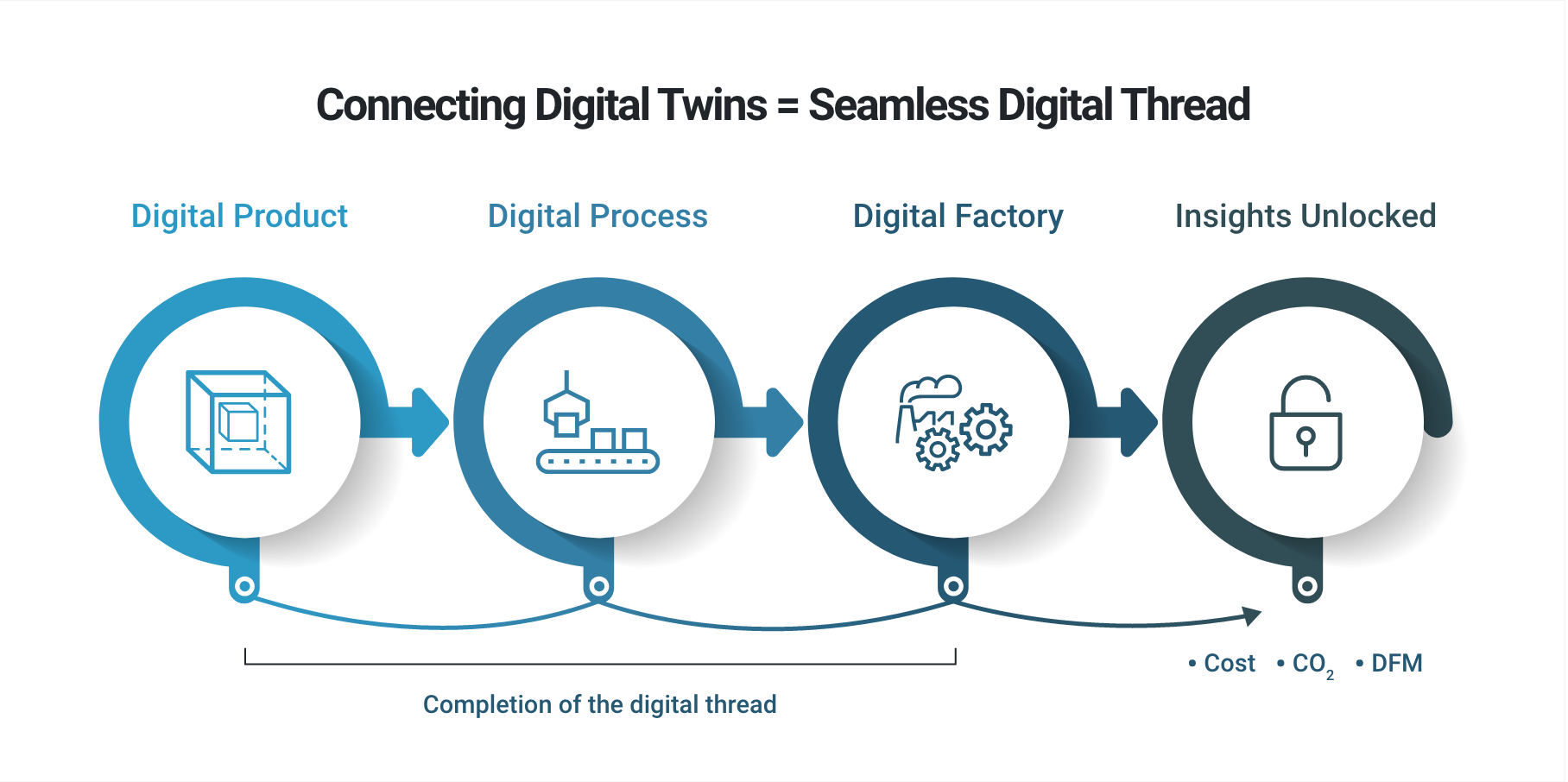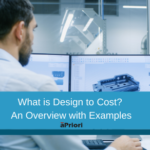
Key Takeaways:
- The manufacturing industry struggles to cut carbon emissions despite incentives
- Digital twin technology can unify and accelerate manufacturing operations
The Full Article:
Manufacturers face escalating pressure from customers, investors, and legislators to reduce their greenhouse gas emissions and address climate change. Despite this business imperative, 93% of companies struggle to be sustainable, according to a 2022 survey of global business decision-makers. Executives often point to challenges gathering and analyzing sustainability data quickly as barriers to reducing carbon emissions.
Successful manufacturers are leveraging their digital transformation (digital twin) investments to make effective decisions based on cost, sustainability, and manufacturability data gathered throughout the organization. Read about the different aspects of digital twins in manufacturing in the following sections of this blog post:
- The New Digital Twin Definition
- Digital Twin Capabilities
- Sustainable Digital Twins from Design through Production
- aPriori Digital Twins for Sustainability
- Why LCAs Don’t Meet Real-time Product Design Needs
- Sustainability Strategies for Growth and Environmental Impact
 The New Digital Twin Definition
The New Digital Twin Definition
As next-generation digital transformation capabilities evolve, industry is expanding the digital twin definition from a single virtual representation of a physical product to multiple interconnected digital twins that can provide powerful product insights instantly.
To put it another way, multiple digital twins are required to optimize a single product across multiple dimensions – including sustainability. Why do we need multiple digital twins? Because product engineering is too complex for a single model (digital twin), according to the July 2022 Journal of Manufacturing Systems.
Digital twin terminology varies, but the overarching approach is the same. McKinsey, Accenture, and other consulting firms refer to “digital twins,” “interconnected digital twins,” and the “enterprise metaverse.” And technical journals describe “digital twin models” and more accurate (but less buzzworthy) terms such as a “digital twin-based industrial information integration system.”
Companies are increasingly using model-based design to accelerate product development and reduce risk by simulating the behavior of a product. And this requires multiple digital twins (e.g., one for finite element analysis [FEA], a second to optimize the manufacturing process for cost and performance, etc.).
And because there is a carbon impact during each phase of the product development lifecycle, manufacturers require a “sustainable digital twin” capability from “cradle-to-gate” (from nurturing a design concept from its infancy [“cradle”] through production [“the factory gate”]).
Learn how to evaluate cost, carbon, and manufacturability trade-offs with aPriori.
Digital Twin Capabilities
Digital/virtual twin technology provides the framework to address today’s complex business environment and the ability to incorporate new applications and address new requirements. Connected digital twins can enable robust features throughout the product development lifecycle that include:
- Simulation: Speed is essential in today’s business environment. And rapid simulation is central to understanding the carbon impact of alternative materials and answering other product design questions required to make effective decisions. aPriori provides product design simulation for cost, manufacturability, and carbon footprint. Other simulation software addresses structural analysis (FEA), fluids, and electromagnetics. But simulation typically does not extend to the manufacturing process or factory location (and specific capabilities). To address this market gap, aPriori enables companies to simulate a variety of manufacturing processes and specific factories and/or manufacturing locations. By extending simulation capabilities throughout the product development lifecycle, manufacturers have the visibility to capture additional savings, reduce carbon emissions, and address supply chain risks proactively.
- Integration (digital thread): The digital thread ties multiple digital twins together and connects product data to a centralized product lifecycle management (PLM) system. The digital thread enables a “single source of truth” for product specification and bill of materials (BOM) data. Digitalization also connects PLM data to enterprise resource planning (ERP) and other systems. And it can also extend business processes across traditionally distinct operations (e.g., product design and sourcing).
- Automation: Improve employee productivity and accuracy by automating key tasks. With aPriori, this includes gaining automated design guidance for each product design change. And it provides automated reports that pinpoint specific design issues to review and address. Teams can also configure automated workflows and set alerts to appear only when individuals are assigned tasks. Management and product teams can access automated reporting of key performance indicators (KPIs) to see progress toward cost, carbon, and manufacturability goals.
- Collaboration: Centralizing product data across departments has limited value if teams from those departments aren’t able to collaborate/analyze findings. Provide teams with a coworking space to work effectively (assign and manage tasks, provide traceability, etc.). This is especially important as teams grow (e.g., product design, cost engineering, sourcing, sustainability, and manufacturing).
Sustainable Digital Twins from Design through Production
An estimated 80% of a product’s early design determines its environmental impact, which highlights the importance of gaining early feedback on a design’s potential carbon footprint. Changes in design, material selection, manufacturing process, and factory location can impact product sustainability – as well as cost and manufacturability.
Product development teams conduct “what if” analysis to evaluate the impact of design changes on key product goals for sustainability and more. Companies use insights from multiple digital twins to unlock actionable, real-time data for better decision-making.
Learn How Grundfos Advances Sustainable Sourcing with Digital Twins
aPriori Digital Twins for Sustainability

Here’s how aPriori’s three digital twins connect across the product development life cycle to gain a holistic view of product sustainability:
1) aPriori Digital Product Twins refer to 3D CAD models or virtual representations of physical products that include components and assemblies, along with overall product size and shape. The digital product twin serves as the design that is optimized via simulation and additional modifications. The digital product twin provides the framework to analyze the current product design and use simulation to see how design changes will affect sustainability, cost, and manufacturability.
- Sustainability Impact: Compare multiple design changes to identify the lowest carbon option. Or, identify the most appropriate design option based on broader cost, carbon, and other criteria. Design simulation scenarios include:
- Using alternative materials to reduce CO2 equivalent (CO2e) emissions, weight, etc.
- Selecting an alternative manufacturing process to save electricity, reduce scrap, etc.
- Updating CAD designs to cut manufacturing times, incorporate alternative materials, etc.
2) aPriori Digital Process Twins determine the most effective way to manufacture a product by simulating manufacturing processes and routings (e.g., injection molding and additive manufacturing). Our physics-based manufacturing process models allow engineering, manufacturing, and purchasing professionals to explore production alternatives down to the machine level. Companies simulate manufacturing processes using the digital twin to identify the most appropriate production process for cost, sustainability, and manufacturability.
- Sustainability Impact: First, it’s important to understand the CO2e calculation accuracy of a manufacturing process. Lifecycle assessment analysis (LCA) software typically calculates carbon based on finished mass. However, it’s more accurate to use rough mass analysis because it includes material waste. For example, when evaluating manufacturing options for electric vehicle control module, aPriori analysis revealed the proposed die cast process generated 4% material waste, compared to nearly 70% for the machining process. The LCA would not have calculated the CO2e from the significant amount of material waste from the machining process. And a poor design that requires additional cuts will produce more waste.
3) aPriori Digital Factory Twins represent physical factories. This virtual model includes precise factory-specific production capabilities along with detailed costs – including labor, electricity, materials, and overhead rates in 87 regions globally. Manufacturers use digital factory twins to help evaluate their supply chain CO2e across the value chain (Scope 3) by creating a virtual representation of supplier factories and their own manufacturing locations.
- Sustainability Impact: Use aPriori to establish a baseline of the total manufacturing costs to produce specific products in different regions. This includes gathering and analyzing:
- Variances in the “green energy” mix by region (e.g., China’s power grid generates more CO2per kWh than Western Europe)
- Regional data (labor rates, direct and indirect overhead rates, and tool shop rates to determine hourly rates to operate each machine by region)
- The unique capabilities of each factory under consideration (e.g., a supplier in India with additional tooling capabilities)
- Options for the lowest energy consumption based on material and manufacturing process
Learn more about the Digital Factory with our in-depth guide.
Why LCAs Don’t Meet Real-time Product Design Needs
LCA software measures CO₂e emissions of a product’s life cycle once the product is designed and produced. LCAs provide a detailed “cradle-to-grave” assessment of a product’s overall environmental impact – from material extraction to end-of-life disposal.
But LCAs don’t provide the rapid sustainability analysis that product development teams require. And many product development teams don’t get a carbon analysis due to limited internal LCA expertise. The lack of sustainability insights is untenable for design teams under deadline to evaluate myriad scenarios for cost, performance, manufacturability, and carbon footprint.
aPriori’s digital twins enable teams to get instant design feedback regarding sustainability, cost, and manufacturability insights. Companies are using aPriori to provide LCAs with precise carbon data from the design and production phases to incorporate into their broader LCA assessments.
Want to learn more? Read “How to Use Life Cycle Assessments in the Product Design Process.”
Sustainability Strategies for Growth and Environmental Impact
The business advantages of sustainability are clear, and this year’s Global 100 ranking of the world’s most sustainable companies underscores this point. Sustainability-related offerings now make up half of the Global 100’s gross revenue compared to just 5% for the wider MSCI ACWI Index benchmark, according to survey organizer Corporate Knights. Global 100 companies also earn 33 times more revenue for every ton of carbon produced, on average, than the nearly 3,000 companies tracked on the MSCI ACWI Index.
The Global 100 ranking showcases the growing disparity between companies that are harnessing sustainability for growth and businesses that are failing to adapt to new market realities.
Manufacturers can close this competitive gap by using digital twins to integrate sustainability insights into overall business operations. This includes making informed decisions quickly to improve sustainability initiatives without sacrificing profits.
Get a Tour of aPriori Sustainability Insights
Watch our on-demand webinar.







